sequoia
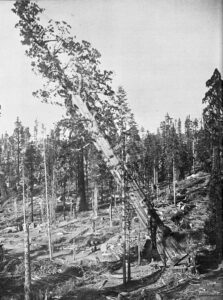
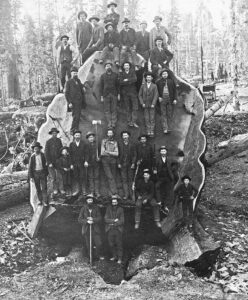 If you have ever wondered about the stupid things people can do, consider this. Most people have heard about the Redwoods in California. Trees just seem to grow much bigger in California, and if you have ever toured the Redwood National and State Parks, you will know what I mean. There is also a Sequoia National Park, and bordering that the Kings Canyon National Park, which was the location of the Mark Twain Tree…a giant sequoia tree located in the Big Stump Forest of Kings Canyon National Park. The giant tree was named after the American writer and humorist Mark Twain. The tree stood 331 feet tall and stretched 16 feet in diameter. It was an amazing tree, but there were people back East and in Europe who did not believe that trees could grow that big. In the late 1800s, travel across the country or from Europe just to see a big tree, was apparently not feasible. Now, I get that it could be difficult, and I get that the government wanted to prove that the tree existed, but what they did was no more than a display of stupidity.
If you have ever wondered about the stupid things people can do, consider this. Most people have heard about the Redwoods in California. Trees just seem to grow much bigger in California, and if you have ever toured the Redwood National and State Parks, you will know what I mean. There is also a Sequoia National Park, and bordering that the Kings Canyon National Park, which was the location of the Mark Twain Tree…a giant sequoia tree located in the Big Stump Forest of Kings Canyon National Park. The giant tree was named after the American writer and humorist Mark Twain. The tree stood 331 feet tall and stretched 16 feet in diameter. It was an amazing tree, but there were people back East and in Europe who did not believe that trees could grow that big. In the late 1800s, travel across the country or from Europe just to see a big tree, was apparently not feasible. Now, I get that it could be difficult, and I get that the government wanted to prove that the tree existed, but what they did was no more than a display of stupidity.
So, the solution was hatched. In 1891, the US Army arrived in California. Their mission was simple. Cut down 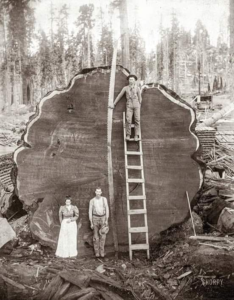 the famous Mark Twain tree so that slices of it could be sent to the American Museum of Natural History. In what is now Kings Canyon National Park, soldiers approached the giant sequoia tree and promptly cut it down. The tree, well known as it was, inspired wonder and doubt from those who had heard about it. Slices of the Mark Twain Tree were sent back to the East Coast and Europe, where it was displayed at museums in New York and London.
the famous Mark Twain tree so that slices of it could be sent to the American Museum of Natural History. In what is now Kings Canyon National Park, soldiers approached the giant sequoia tree and promptly cut it down. The tree, well known as it was, inspired wonder and doubt from those who had heard about it. Slices of the Mark Twain Tree were sent back to the East Coast and Europe, where it was displayed at museums in New York and London.
The project took 13 days and was carried out by lumbermen Bill Mills and SD Phips, with assistance from Barney and John Lukey. The tree was later shipped to the American Museum of Natural History in New York and the British Museum in London at the expense of Collis P Huntington, the president of the Southern Pacific Railroad. I suppose it is easy enough to understand why people couldn’t believe the huge trees were real. And for the Sequoia trees, even though the Sequoia National Park was established in 1890, access to the sequoia groves was difficult and the existence of such large trees was not widely believed at the time. I suppose some people might think that could justify the actions of the US Army and the US government, but to me it was a travesty, and a complete display of stupidity. So, to prove the tree could grow that big, they killed it, so they couldn’t see how big it could really grow. All to prove a point, 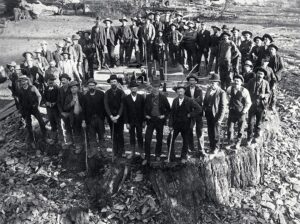
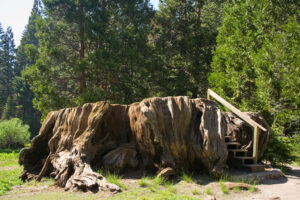 because there were those who thought the story was bogus.
because there were those who thought the story was bogus.
Today, you can see the Mark Twain stump, and the other remains of the tree, which are preserved as part of the Big Stump Picnic Area in Kings Canyon National Park. The stump is near the entrance to Grant Grove. The stump stands there as a monument to the stupidity of some men.
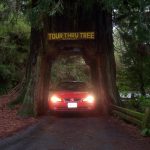
![]() Yesterday, I heard the news that one of the iconic giant sequoia trees, located in Calaveras Big Trees State Park, in California’s Sierra Nevada Mountains, is gone. The tree had been hollowed out to allow cars to drive through it. The Pioneer Cabin Tree, usually referred to as simply the “tunnel tree,” is estimated to be over 1,000 years old. It was knocked over by a powerful winter storm that slammed into California on Sunday. While the tunnel had been carved out of the tree, it was still very much a living tree.
Yesterday, I heard the news that one of the iconic giant sequoia trees, located in Calaveras Big Trees State Park, in California’s Sierra Nevada Mountains, is gone. The tree had been hollowed out to allow cars to drive through it. The Pioneer Cabin Tree, usually referred to as simply the “tunnel tree,” is estimated to be over 1,000 years old. It was knocked over by a powerful winter storm that slammed into California on Sunday. While the tunnel had been carved out of the tree, it was still very much a living tree.
I immediately though back to a vacation my husband, Bob and I took a few years back, that took us through the scenic Redwood National Park in northern California. While the tree that we were able to drive through was not the one that was toppled in this storm, I still felt the loss of that amazing tree. The giant sequoia is the world’s largest tree, after all, and it is only found in the western slopes of the Sierra Nevada Mountains. It can reach a height of 325 feet. This particular tree, called the Pioneer Cabin Tree was actually hollowed out in about 1880. For a long time, cars drove through the iconic tree, but in recent years, it was only accessible by hiking trail. I thought about the tree we drove through, and how much fun it was to see such a huge tree. I was quite saddened by the loss of this beautiful tree.
Apparently, a volunteer, Jim Allday was in the park on Sunday when the tree came crashing down. It was about 2 pm, and the tree splintered on impact. The thing that he found most concerning was that visitors had been walking through the tree just hours earlier. He went out to the site to find the tree on the ground, and what ![]()
![]() looked like a pond or river running through it. The river was most likely the cause of the tree’s demise. The powerful winter storm brought heavy rain and snow to the area. It was the worst flooding in over a decade. The storm forced the closing of Yosemite National Park. It brought with it, hurricane-force winds of over 100 miles per hour. The wind and soggy ground were just too much for the giant tree. For people in the area, and anyone who has ever had the opportunity to see the tree and the park, it feels like losing a famous historical figure, and at 1,000, it was a great historical figure indeed.
looked like a pond or river running through it. The river was most likely the cause of the tree’s demise. The powerful winter storm brought heavy rain and snow to the area. It was the worst flooding in over a decade. The storm forced the closing of Yosemite National Park. It brought with it, hurricane-force winds of over 100 miles per hour. The wind and soggy ground were just too much for the giant tree. For people in the area, and anyone who has ever had the opportunity to see the tree and the park, it feels like losing a famous historical figure, and at 1,000, it was a great historical figure indeed.

